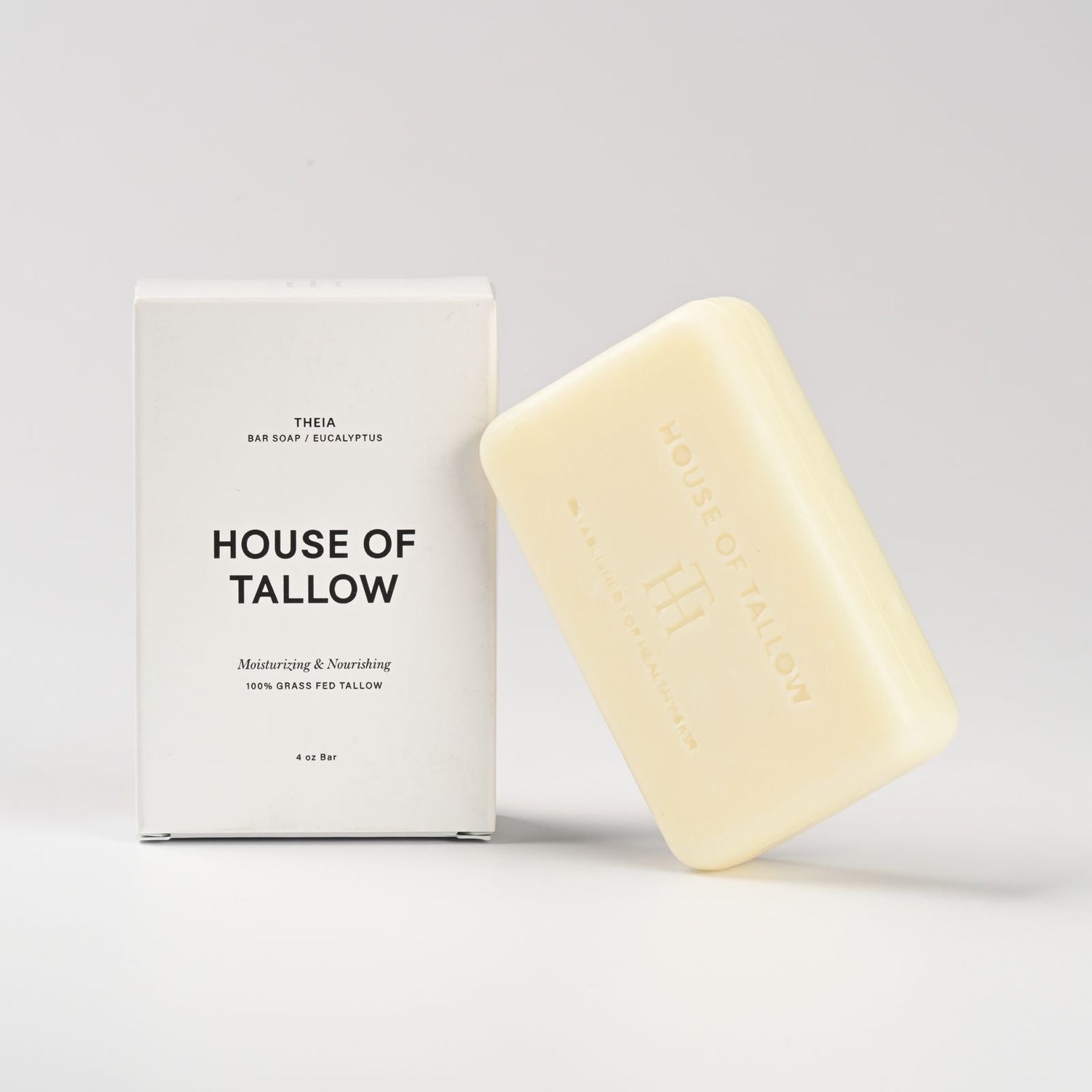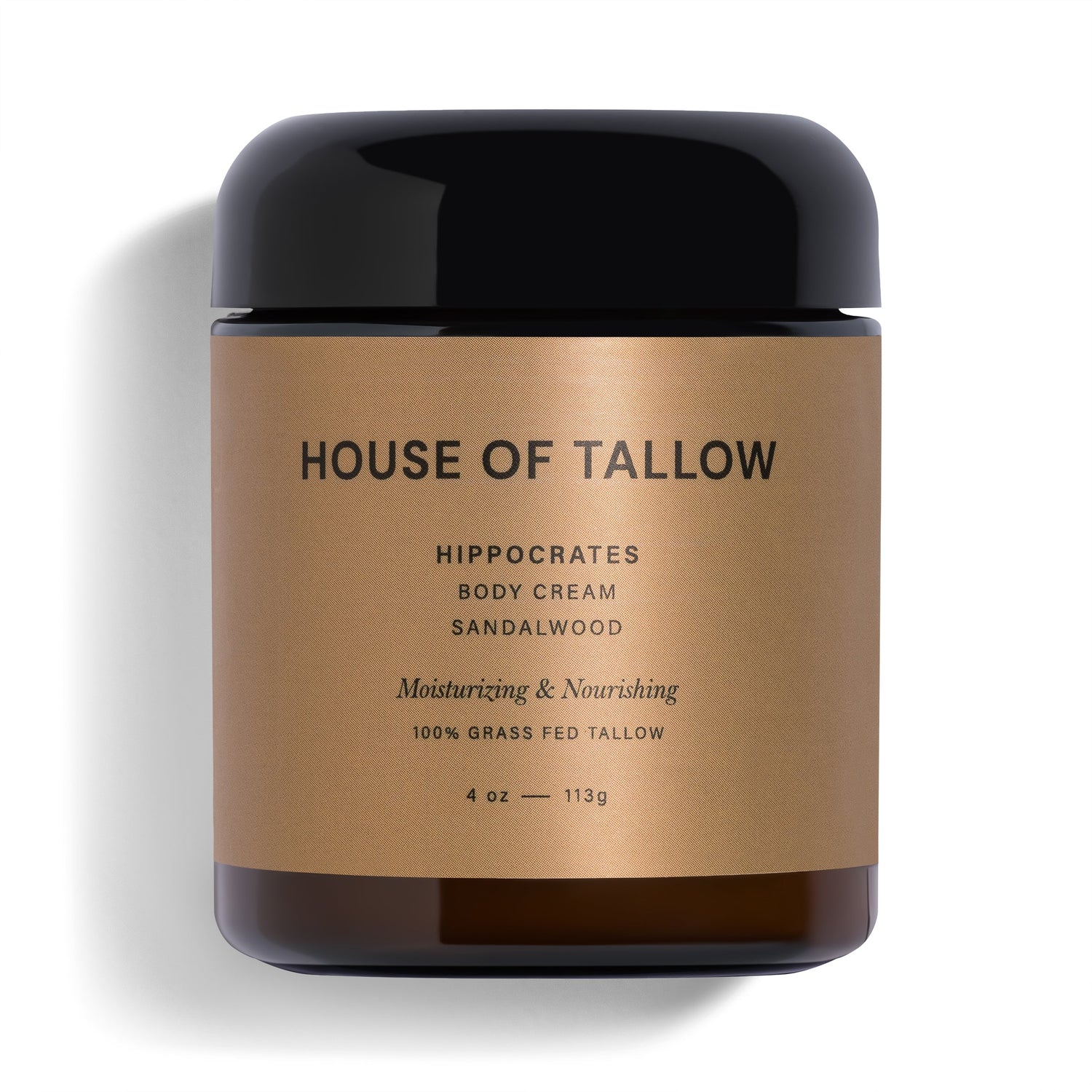Tallow is a natural fat derived from animals, known for its ability to soothe skin inflammation like eczema and psoriasis. It closely mimics human skin, making it easy to absorb and deliver nutrients such as essential fatty acids (oleic, palmitic, stearic) and vitamins A, D, E, and K. These components strengthen the skin barrier, calm redness, and promote healing. Unlike synthetic moisturizers, tallow penetrates deeply without clogging pores, making it a gentle, effective option for sensitive or inflamed skin. For best results, choose grass-fed tallow products for higher nutrient content.
Key Benefits of Tallow for Skin:
- Anti-inflammatory: Reduces redness and irritation.
- Rich in nutrients: Packed with fatty acids and vitamins.
- Deep hydration: Absorbs into deeper skin layers.
- Skin barrier repair: Strengthens and protects the skin.
Use it as part of your routine by applying a small amount to damp skin, and pair it with soothing ingredients like aloe vera or chamomile for added benefits. Always start with a patch test to ensure compatibility.
Reasons Why Skin Loves Grass Fed Tallow
What is Tallow and How it Helps with Skin Inflammation
Tallow is a purified fat derived from animals, typically cattle or sheep, through a process called rendering [1][3].
Tallow's Nutrient Composition
Tallow owes its benefits to its impressive nutrient makeup:
| Components | Benefits for Skin |
|---|---|
| Oleic, Stearic, Palmitic Acids | Strengthens the skin barrier, reduces irritation |
| Vitamins A, D, E, K | Supports cell repair and provides antioxidant defense |
| CLA (Conjugated Linoleic Acid) | Helps soothe irritation and aids in skin recovery |
What makes tallow stand out is how closely it resembles human sebum. This similarity allows it to deeply penetrate and nourish irritated skin [2][4].
Tallow for Inflamed and Sensitive Skin
Skin inflammation often shows up as redness, swelling, or irritation. Common triggers include:
- Environmental factors
- Allergic reactions
- Conditions like eczema or psoriasis
- A weakened skin barrier
When the skin barrier is compromised, it becomes more prone to irritation and damage [2][3].
Tallow offers a gentle yet effective solution for sensitive or inflamed skin. Its stearic and palmitic acids work to repair the skin barrier while creating a protective shield against external stressors [1][3]. Packed with essential fatty acids and vitamins, tallow helps ease redness and irritation while promoting overall skin recovery.
Unlike synthetic moisturizers, which may contain harsh chemicals, tallow provides deep hydration without clogging pores [2][3]. For the best results, look for products made with grass-fed tallow, as it contains higher levels of nutrients. For instance, brands like House of Tallow use grass-fed tallow in their products, ensuring better support for inflamed or sensitive skin.
The Science of Tallow's Anti-Inflammatory Properties
How Tallow's Fatty Acids Help Heal Skin
Tallow's ability to calm inflammation comes from its specific fatty acid composition, which works directly at the cellular level. These fatty acids help block signals that trigger inflammation, offering natural relief for irritated skin.
| Fatty Acid | Percentage | How It Helps with Inflammation |
|---|---|---|
| Oleic Acid | 47% | Penetrates deeply, reduces inflammatory signals |
| Palmitic Acid | 26% | Strengthens skin's barrier, soothes irritation |
Research from 2021 highlighted that conjugated linoleic acid (CLA) in tallow significantly reduced inflammation in the skin, showing clear decreases in markers tied to inflammatory responses [2][4].
Anti-Inflammatory Vitamins in Tallow
Grass-fed tallow is packed with vitamins that amplify its calming properties. Each vitamin plays a role in fighting inflammation through targeted pathways:
- Vitamin A: Regulates how skin cells respond to inflammation [1][4]
- Vitamin D: Helps control immune activity in the skin
- Vitamin E: Shields skin from oxidative stress, reducing inflammation
- Vitamin K: Minimizes redness and aids the healing process
Studies have shown that tallow-based treatments significantly improve conditions like atopic dermatitis and psoriasis. The natural compatibility between tallow's structure and human skin allows these vitamins and fatty acids to be absorbed efficiently, making it a powerful option for managing skin inflammation [2][4].
This natural match between tallow's nutrients and human skin highlights its potential as an effective alternative to synthetic anti-inflammatory products, offering relief and support for healthier skin.
sbb-itb-a1b9fc0
Using Tallow in Your Skincare Routine
Choosing the Right Tallow Products
The benefits of tallow in soothing inflammation depend heavily on the quality of the product you select. Opt for tallow sourced from grass-fed animals and processed using cold methods to retain its nutrients. Look for products that include natural and organic ingredients to boost their effects. For instance, House of Tallow's Gaia Body Cream (unscented) and their eucalyptus-infused Theia Body Cream are great examples. Both use grass-fed tallow as the main ingredient, meeting high standards for purity and effectiveness.
Once you've found a quality tallow product, applying it correctly can make all the difference.
How to Use Tallow for Inflammation
Start by cleansing your skin with lukewarm water. Then, while your skin is still damp, gently pat a small amount of tallow onto the inflamed areas. Use it twice a day or whenever flare-ups occur. If you have sensitive skin, you can take a few extra steps to ensure the product works well without causing irritation.
Advice for Sensitive Skin
If your skin is sensitive, consider pairing tallow with soothing ingredients that target specific concerns. For example, chamomile can help with redness, aloe vera provides a cooling effect, and green tea offers protection for chronic inflammation [1][3]. Unscented options like House of Tallow's Gaia Cream or Baby Cream are particularly good choices for minimizing irritation while still delivering the anti-inflammatory benefits of tallow [2][4].
Here’s a quick guide to natural ingredients that complement tallow:
| Ingredient | Benefit | Best For |
|---|---|---|
| Chamomile | Calms redness | Acute inflammation |
| Aloe Vera | Cools skin | Heat-related irritation |
| Green Tea | Protects | Chronic inflammation |
Ingredients That Work Well with Tallow
Natural Oils and Extracts to Pair with Tallow
Tallow is already a great option for skincare, but combining it with certain natural ingredients can make it even more effective. For example, calendula is a standout partner for tallow-based products. Research shows that mixing calendula extract with tallow can help treat skin issues like venous leg ulcers and radiation-induced dermatitis [5].
Here’s a quick look at how tallow pairs with some natural extracts:
| Natural Extract | Benefits | Works with Tallow By... |
|---|---|---|
| Calendula | Reduces inflammation, fights microbes | Improving absorption of active ingredients |
| Tea Tree Oil | Fights bacteria and fungi | Preventing infections while tallow hydrates |
| Aloe Vera | Soothes and cools the skin | Boosting tallow's moisturizing effects |
| Lavender | Calms and promotes healing | Adding a relaxing scent to tallow's care |
These ingredients work well on their own, but when paired with tallow, they can offer even more skin benefits.
Using Tallow with Other Remedies
To get the best results, use tallow after applying other treatments to lock in their effects. For example, combine it with aloe vera for a cooling effect, calendula for healing, or tea tree oil to keep infections at bay. Always start with a small amount to check for any skin sensitivity and focus on combinations that address your specific needs.
Timing is key when layering products. Applying tallow after active treatments helps seal in their benefits while also delivering extra hydration and soothing properties. This approach ensures that each ingredient works to its fullest potential.
Precautions and Limits of Using Tallow for Skin Care
Allergic Reactions to Tallow
Tallow is generally well-tolerated, but some individuals may experience allergic reactions. Signs of sensitivity include redness, itching, swelling, or rashes. To minimize risks, perform a 24-hour patch test before applying tallow to larger areas.
| Reaction Level | Signs | Recommended Action |
|---|---|---|
| Mild | Slight redness or itching | Observe; stop use if symptoms persist |
| Moderate | Swelling, ongoing itching, or rash | Discontinue immediately |
| Severe | Intense inflammation or blistering | Seek medical attention right away |
When to Consult a Dermatologist
If your skin condition worsens or shows no improvement with tallow, it’s time to seek professional advice. Dermatologists can help, especially for:
- Chronic inflammation that remains unchanged
- Severe acne flare-ups
- Long-standing skin issues that resist treatment
- Unusual skin reactions after using tallow-based products
The Role of Tallow in Chronic Skin Disorders
Tallow can be a helpful addition to skincare routines, particularly for its moisturizing and soothing effects. Studies suggest it may help reduce symptoms of dermatitis, but it’s not a standalone solution for chronic conditions [4]. For these issues:
- Incorporate tallow into a broader treatment plan.
- Keep your healthcare provider informed about its use.
- Track how your skin reacts to combined treatments.
- Adjust usage based on professional recommendations.
Tallow can improve skin health, but it’s most effective when paired with expert care for persistent or severe conditions.
Conclusion: Tallow for Managing Skin Inflammation
Tallow has shown great promise in easing skin inflammation, thanks to its molecular structure that closely resembles human skin [2]. This compatibility allows it to work as a natural option for addressing various inflammatory skin issues.
Studies highlight that tallow-based emulsions can help reduce symptoms of atopic dermatitis by lowering IgE levels [4]. Packed with vitamins A, D, E, and K, along with omega-3 and linoleic acid, tallow helps reinforce the skin barrier and promotes faster healing.
For those looking to incorporate natural remedies into their skincare, tallow is a solid choice. The quality of the tallow makes a big difference - grass-fed tallow, for example, contains up to four times more vitamins than conventional options. Brands like House of Tallow stand out by offering products crafted with responsibly sourced, grass-fed tallow, ensuring both effectiveness and care in their formulations.
When used as part of a consistent skincare routine, tallow can help manage inflammation and improve overall skin health. Prioritize high-quality, well-sourced tallow products to get the most out of its natural benefits.




